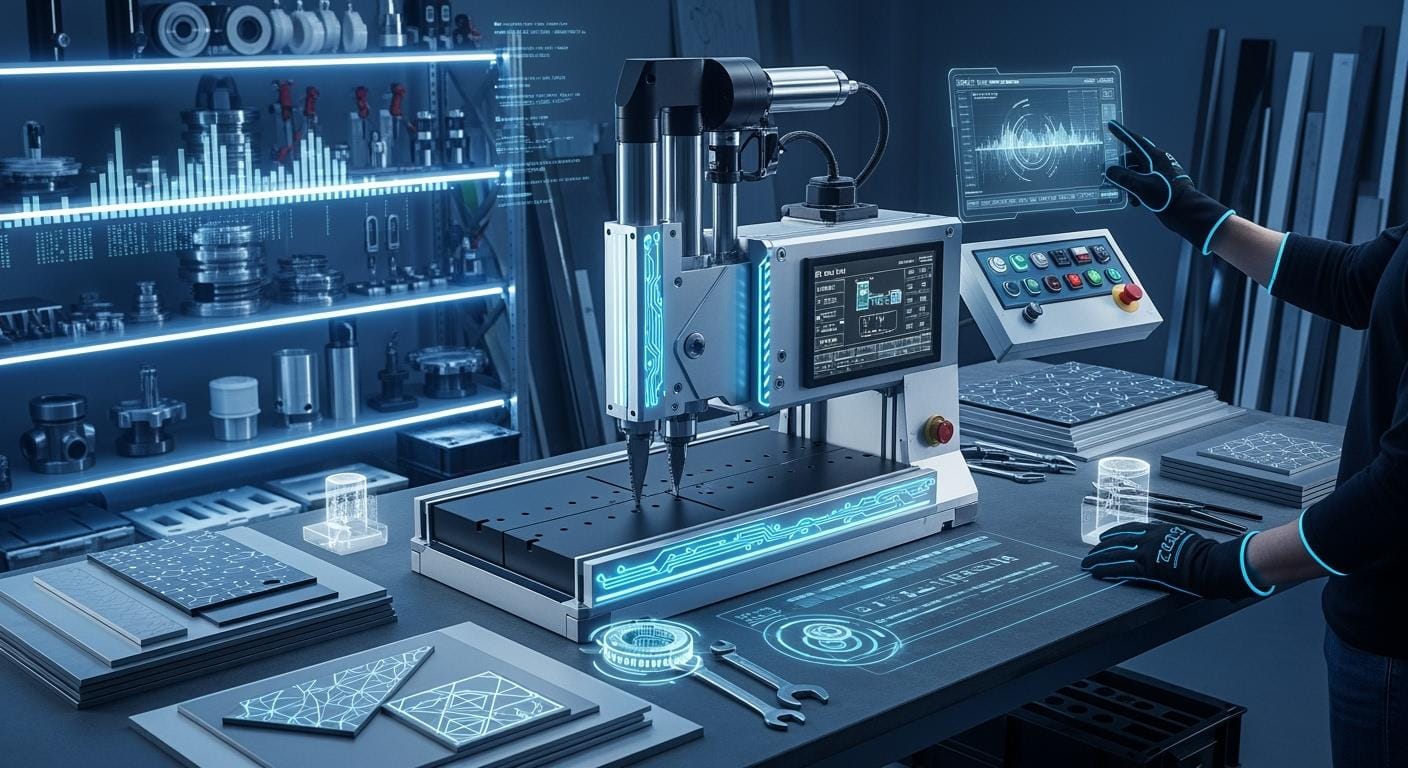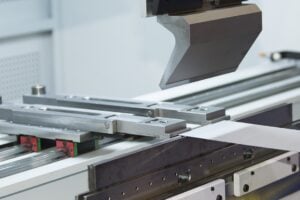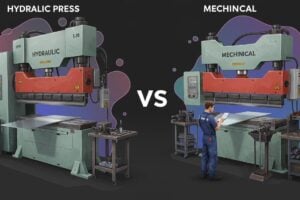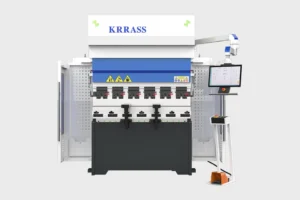Have you ever stood in your workshop, looking at a pile of metal, and wondered if your current shearing machine can handle the job? I know that picking the right hydraulic shear isn’t just about power. It’s about matching the machine to your materials, thickness, and daily tasks. The wrong shears can slow you down, cost more, and even make work less safe. With so many hydraulic shearing machine options out there, it’s easy to feel lost.
Table of Contents
Key Takeaways
Picking the right hydraulic shear helps match it to your work. Hydraulic shears use strong force to make clean cuts. They are great for many different jobs. Think about the metal’s thickness and type you cut most. This helps you pick the best shear. Look for features like blade changes and backgauge systems. These help you cut more accurately. Automatic shears can help you work faster. They let you cut more pieces with less work. Strong steel frames make machines last longer. Good build quality is very important. Safety features like guards keep workers safe. Emergency stops help protect people during use. Take care of your machine with regular checks. Good support from suppliers helps your machine work well.
Hydraulic Shears Overview
What Is a Hydraulic Shear
When I started working with metal, I saw that not all cutting tools are the same. A hydraulic shear is a strong machine. It uses hydraulic force to cut metal sheets, plates, and bars. I use hydraulic shears when I want clean and straight cuts. These machines make cutting easy and fast. Workshops and factories use them a lot. They can do hard jobs that hand tools cannot do.
Hydraulic shears are important in many jobs. Here are some ways people use them:
- Metal fabrication: Cutting sheets, plates, and bars for machines and goods.
- Automotive: Shaping metal for car bodies, frames, doors, and hoods.
- Aerospace: Cutting light metals like aluminum for airplane panels.
- Construction: Cutting steel plates and bars for buildings.
- Shipbuilding: Shaping metal plates for ships and boats.
- Electronics: Cutting metal cases and parts for appliances.
How Hydraulic Shears Work
I think hydraulic shears work in a cool way. The machine has an oil pump. It sends hydraulic oil into pressure cylinders. When I press the control, oil goes into the left and right cylinders. This pushes the tool post down. The top blade moves down and presses the metal sheet. Shearing force and torque keep the sheet still. As the blade goes deeper, the angle changes. The metal breaks apart when the blade cuts through. After the cut, a spring helps the oil go back to the tank. The blade moves up and gets ready for the next cut.
Hydraulic shears and mechanical shears are different. Here is a table to show how they compare:
| Feature | Hydraulic Shears | Mechanical Shears |
|---|---|---|
| Cutting Speed | Slower, about 20-30 cuts each minute | Faster, about 60-100 cuts each minute |
| Cycle Time | Longer because of slow hydraulic moves | Shorter because of quick mechanical moves |
| Precision | Very precise with careful cutting | Less precise, better for lots of work |
Types of Hydraulic Shears
People often ask me about types of shearing machines. Each type is good for different jobs. The best one depends on what your workshop needs.
Guillotine Shears
Guillotine shears have a straight blade. The blade moves down to cut the metal. I like these shears because they are accurate. They can cut thick materials. They are good for big jobs and are used in large workshops.
Swing Beam Shears
Swing beam shears have a blade that swings in an arc. It does not move straight down. I use these shears for medium-thick materials. They make smooth cuts. They are easy to take care of. Many workshops pick swing beam shears for their power and accuracy.
Specialty Shears
Specialty shears are made for special jobs. Some have rotary blades. Others have fixed or mechanical hydraulic systems. Rotary hydraulic shears can do demolition work. Fixed hydraulic shears give high force but do not spin. I use specialty shears when normal machines cannot do the job.
Tip: If you do not know which shearing machine to pick, think about what materials you cut most. Also, think about how exact you want your cuts. The right machine can help you work faster and safer.
Key Factors in Choosing the Right Shearing Machine
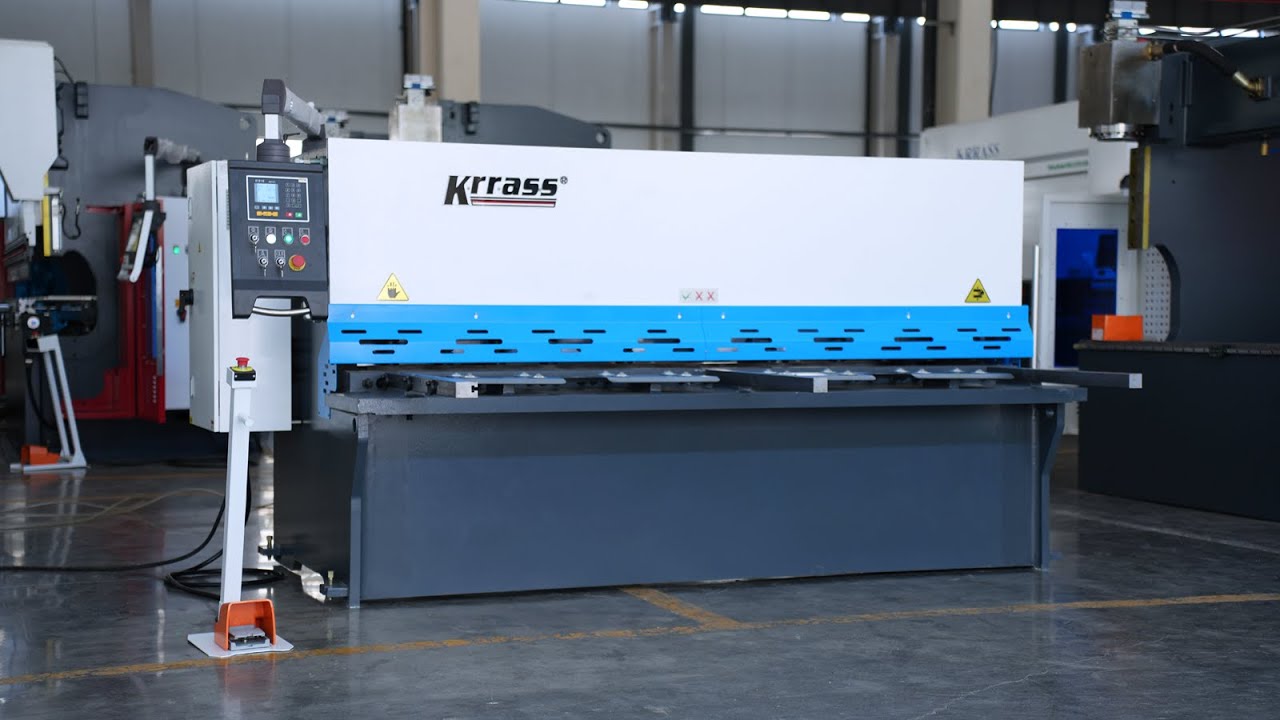
Material and Thickness
Shear Capacity
When I pick a shear, I first think about what I need to cut. Not every shearing machine can do every job. Most industrial shears cut mild steel up to 1/2 inch thick. If I want to cut thicker metal, I need a special machine. Thicker metal needs more power from the machine. As metal gets thicker, the cut might not look as nice. Sometimes, thick sheets need extra setup to stop rough edges.
Here’s a quick look at common materials and their thickness ranges:
| Material Type | Thickness Range (mm) |
|---|---|
| Mild Steel | 6 – 25 |
| Stainless Steel | Reduced by 30-50% |
If I double the metal’s thickness, I need four times more force. That’s why I always check the specs before buying. I want my shearing machine to fit my jobs.
- Most industrial shears cut mild steel up to 1/2 inch thick.
- Thicker materials need special machines.
- More thickness means more power is needed.
- Thick metal can make the cut look rough.
Material Compatibility
I work with many metals in my shop. Some days I cut mild steel. Other days I cut stainless steel or aluminum. Not all shears work well for every metal. I always check if the machine can cut the metals I use most. Stainless steel is harder to cut than mild steel. The machine’s capacity drops by 30-50% when I switch to stainless steel. I read the manufacturer’s guide for each machine. This helps me avoid mistakes and keeps my cuts clean.
Cutting Capacity and Blade Length
Max Thickness
When I pick a shearing machine, I check the max thickness and length it can cut. Guillotine shearing machines usually cut up to 6mm. Hydraulic shears can cut thicker metal. I want a machine that fits my daily work. I also look for machines that cut different metals, like mild steel, stainless steel, and aluminum. Each metal has its own cutting limit, so I check the specs.
- Check the max length and thickness the machine can cut.
- Guillotine shearing machines cut up to 6mm.
- Hydraulic shearing machines cut thicker metal.
- The machine should work with mild steel, stainless steel, and aluminum.
Blade Adjustability
Blade adjustability is important for my work. I need to change the blade gap for different metal thicknesses. If the gap is too wide or too tight, the cut will not look good. Many companies give details about blade gap settings. I look for machines with easy blade adjustment. This helps me get better cuts and keeps blades sharp longer.
- Companies give cutting capacity details for each metal.
- Blade gap can be changed for different thicknesses.
- Cutting capacity changes with each metal type.
The cutting capacity of hydraulic shears depends on blade size and material. Wider blades cut thicker metal more easily. Thicker blades make the machine stronger and last longer. This lets me use my shearing machine for more jobs.
Precision and Accuracy
Backgauge Systems
I want every cut to be perfect. That’s why I care about the backgauge system. A good backgauge holds the metal in place and sets the distance from the blade. This makes my cuts more accurate. I like machines with digital or motorized backgauges. They save time and help me make fewer mistakes.
- A good backgauge keeps the metal in the right spot.
- The backgauge sets the distance from the blade.
- This helps make every cut accurate.
Blade Quality
Blade quality is very important in my shop. Sharp, strong blades give me clean cuts and less waste. I always check what the blades are made of. Good blades last longer and keep my machine working well. If the blades get dull, I sharpen or replace them.
- Blade quality and sharpness help make clean cuts.
I also check the gap between blades. If I set the gap right, my cuts are cleaner. Hydraulic controls help me make small adjustments. Some machines, like the KRRASS QC12K and QC11K, use new technology for better accuracy. CNC controls and easy buttons help me set up the machine fast and get the results I want.
Tip: For the best results, match your machine’s specs to your needs. Look for features like a motorized rear stopper or tandem cylinder system. These can help you work faster and more accurately.
Production Volume
Manual vs. Automatic
When I look at shearing machines for my workshop, I always think about how much work I need to do each day. If I only cut a few sheets now and then, manual shears might work for me. These shears need more hands-on effort. I have to line up the metal, set the blade, and push the controls for every cut. Manual shearing works best for small jobs or when I want to save money.
If I run a busy shop with lots of orders, I need automatic shears. These machines handle more cutting with less effort from me. I just set the size, load the metal, and let the machine do the work. Automatic shearing machines, like the KRRASS QC12K and QC11K series, come with features such as centralized control buttons and motorized rear stoppers. These features help me finish jobs faster and keep every cut the same. I can trust automatic shears to keep up with high production needs.
Cycle Speed
Cycle speed tells me how fast a shearing machine can finish one cut and get ready for the next. If I have a lot of metal to cut, I want a machine with a high cycle speed. Fast cycle speed means I can finish more work in less time. Some industrial shears can make up to 30 cuts per minute. I always check the specs for cycle speed before I buy. This helps me pick a machine that matches my workload.
Tip: If you want to boost your workshop’s output, choose automatic shears with a high cycle speed. This will help you meet deadlines and keep customers happy.
Durability and Build Quality
Frame Construction
I want my shearing machine to last for years, even when I use it every day. That’s why I look at how the frame is built. Most hydraulic shears use strong steel frames. This steel construction helps the machine handle tough jobs and keeps it steady during cutting. I also check for reinforced frames. These frames support higher cutting capacities and make sure the machine stays accurate, even with heavy use.
Here are some things I look for in a durable shearing machine:
- Steel construction for strength and long life
- Reinforced frames for better support during heavy-duty cutting
- Design features that help the machine cut through thick steel plates and girders
I know that a well-built frame means fewer repairs and less downtime. My workshop runs smoother when I don’t have to worry about the machine breaking down.
Brand Reputation
I always pay attention to the brand when I buy new shearing equipment. A good brand means I can trust the machine to work well and last a long time. Brands like KRRASS, US Industrial, Betenbender, and GMC Machinery have strong reputations in the industry. They use high-strength steel and smart designs to make their machines reliable.
Here’s a quick table to show what I look for:
| Element | Description |
|---|---|
| Material and Design | Frames made from high-strength steel. Some designs use vibration dampening for better precision. |
| Reinforcement | Reinforced frames help with higher cutting capacities and steady performance during tough jobs. |
When I choose a trusted brand, I know I’m getting a machine that will keep up with my workshop’s needs.
Safety Features
Guards and Emergency Stops
Safety always comes first in my workshop. I never want anyone to get hurt while using shearing machines. That’s why I look for safety features like guards and emergency stop buttons. Guards block access to the cutting area, so fingers and hands stay safe. Emergency stops let me shut down the machine right away if something goes wrong.
Here are some safety steps I always follow:
- Wear gloves, goggles, and steel-toed shoes
- Never adjust blades or do maintenance while the machine is running
- Keep the work area clean and free of clutter
- Make sure all operators know how to use the machine safely
Some machines also have warning lights and mirrors for better visibility. I check that the finger protector is at the right height to prevent injuries.
| Safety Measure | Description |
|---|---|
| Guards | Safety guards and barriers block access to cutting points. |
| Emergency Stops | Emergency stop buttons halt the machine if there’s a problem. |
| Ergonomics | Training on safe lifting and handling keeps operators healthy. |
Operator Ergonomics
I want my team to feel comfortable and safe while working. Good operator ergonomics means less strain and fewer injuries. I look for shearing machines with easy-to-reach controls and clear displays. Training my team on safe lifting and handling helps everyone stay healthy. When the machine is easy to use, we make fewer mistakes and work faster.
Note: Regular maintenance and safety checks keep my shearing machines running smoothly and help prevent accidents. I always make sure my team knows the safety rules and follows them every day.
Ease of Use and Maintenance
Control Systems
When I work with shearing machines, I want controls that make my job easier. I look for simple buttons and clear displays. If the controls confuse me, I waste time and risk mistakes. KRRASS hydraulic shears stand out because they use centralized control systems. I can adjust settings with one button. This saves me time and helps me focus on cutting.
Modern shears often come with real-time monitoring. I can see machine status and spot problems before they slow me down. Some industrial shears even offer predictive maintenance. The machine tells me when it needs attention. This keeps my workflow smooth and reduces downtime.
User-friendly interfaces matter a lot. I train new team members faster when the controls are easy to learn. Fewer errors happen when everyone understands the system. KRRASS QC12K and QC11K series use intuitive controls. I set up jobs quickly and get precise cuts every time.
Here’s a table that shows how control systems and support make shearing easier:
| Feature | How It Helps Me |
|---|---|
| Real-time monitoring and predictive maintenance | I catch issues early and avoid long repairs. |
| User-friendly interfaces | My team learns fast and makes fewer mistakes. |
| Cloud-based diagnostics | Experts help me fix problems without coming to my shop. |
Tip: If you want less stress and more productivity, choose shears with smart control systems. You’ll spend more time cutting and less time troubleshooting.
Service and Support
I know that even the best shearing machines need care. Good service and support keep my hydraulic shear running strong. I always check if the manufacturer offers help when I need it. KRRASS gives me access to experts who answer my questions and solve problems fast.
Maintenance is key for long-lasting shears. I follow a routine to keep my machines in top shape. Here’s what I do:
- I inspect internal parts, hydraulic lines, and electrical connections often.
- I check blades for wear. If they need sharpening or replacing, I act quickly.
- I make sure the back gauge and squaring arm stay aligned for accurate cutting.
- I keep fluid levels right and inspect hoses for leaks.
- I set up a schedule for regular checks and part replacements.
- I write down every maintenance task in a log. This helps me track issues and stay compliant.
When I buy industrial shears, I want strong after-sales support. KRRASS offers remote diagnostics. Their experts can look at my machine’s data and guide me, even if I’m far away. This saves me time and money. I trust their team to help me keep my shearing machines working safely and efficiently.
Note: Regular maintenance and good support mean fewer breakdowns and better results. I always choose shears from brands that care about their customers.
Matching Hydraulic Shears to Workshop Needs
Assessing Workflow
When I look at my workshop, I always start by thinking about how we work every day. I ask myself, “How many sheets do I need to cut? What size and thickness do I handle most?” I know that matching the right shearing machine to my workflow can save time and money. I use a simple table to help me break down what matters most:
| Factor | Description |
|---|---|
| Production Volume | I choose hydraulic shears for small to moderate jobs. They keep things efficient and cost-effective. |
| Material Thickness | I want a machine that handles different thicknesses with precision. |
| Customization Options | I look for shears that let me adjust cutting capacity and blade size. |
| Control Systems | I pick between manual and CNC controls based on my budget and needs. |
I find that this table helps me see what features matter for my daily work. If I run a busy shop, I need a shearing machine that keeps up with high production. If I do custom jobs, I want more control and flexibility.
Material Demands
Every workshop has its own set of materials. I often cut mild steel, but sometimes I work with stainless steel or aluminum. The type and thickness of metal shape my choice of shears. Here’s what I always consider:
- Material type and thickness play a big role. Some shears work better for thin sheets, while others handle thick plates.
- Production volume matters. If I need to cut a lot, I look for shearing machines with faster speeds and automation.
- Machine size and space count too. My workshop only fits certain models, so I measure before I buy.
I never forget that the right shearing machine must match my material needs. If I pick the wrong one, I waste time and risk poor cuts.
Budget and Cost of Ownership
Buying a shearing machine is a big step. I look past the price tag and think about the total cost. Here’s a table that helps me compare:
| Factor | Description |
|---|---|
| Initial Purchase Costs | I check the size, brand, and features of the shears. |
| Ongoing Maintenance Expenses | I plan for regular upkeep, blade changes, and repairs. |
| Energy Efficiency and Operational Costs | I track electricity and hydraulic oil use. |
| Long-term Considerations | I value good support, training, and warranties. |
| Supplier Relationship | I trust suppliers who offer fair prices and fast help. |
| Qualitative Factors | Reliable shearing machines mean fewer surprises and better results. |
I also think about upgrades. I want shears that can adapt to new technology. This helps me avoid buying a new machine too soon. A good supplier makes a big difference. They help me save on repairs and keep my shearing machine running strong.
Tip: Always look at the big picture. The right shearing machine pays off with lower costs, better cuts, and less downtime.
Space and Utilities
When I think about adding a new hydraulic shear to my workshop, I always look at my space first. I know that even the best machine won’t help if I can’t fit it in my shop. I measure the floor area and check the doorways. Some shears are big and heavy. I make sure I have enough room to move metal sheets around the machine. I also leave space for maintenance and cleaning. If I crowd the machine, my team and I can’t work safely.
I like to draw a simple layout of my workshop. I mark where the shear will go. I check if I have enough space for loading and unloading metal. I also think about where I will store finished pieces. If I plan well, I avoid headaches later.
Here’s a quick checklist I use before I buy a new shear:
- Measure the floor space and ceiling height.
- Check the weight of the machine and the strength of the floor.
- Make sure there’s enough room for operators to move safely.
- Plan for storage of raw materials and finished parts.
- Leave space for maintenance access.
Utilities matter just as much as space. Hydraulic shears need power. Some models use more electricity than others. I check the voltage and phase requirements. I ask my electrician if my shop can handle the load. I also look at the hydraulic oil system. I make sure I have a safe place to store oil and handle spills.
Some machines, like the KRRASS QC12K and QC11K series, use advanced electronics. These models may need stable power and good ventilation. I always read the manual and talk to the supplier about utility needs.
Here’s a table I made to help me remember what to check:
| Utility | What I Check |
|---|---|
| Electricity | Voltage, phase, and circuit capacity |
| Hydraulic Oil | Storage, handling, and spill safety |
| Ventilation | Airflow for cooling and safety |
| Lighting | Bright lights for safe operation |
Tip: I always talk to my supplier about space and utility needs before I buy. They help me avoid surprises and set up my workshop for success.
I learned that planning for space and utilities saves me time and money. My team works better when the shop feels open and safe. I get more done when I don’t have to worry about power or cramped spaces. If you want your new hydraulic shear to work well, start with a good plan for space and utilities.
Buying Shears: New vs. Used
When I started thinking about buying shears for my workshop, I had to decide between new and used machines. This choice can feel tricky. I want to share what I learned to help you make the best decision for your shop.
Pros and Cons of New Shears
New shears come packed with the latest features. I get peace of mind knowing everything works right out of the box. Here’s a table that helped me weigh the good and the bad:
| Advantages of New Shears | Disadvantages of New Shears |
|---|---|
| Larger shearing force for tough jobs | Higher energy use |
| CNC system for automatic, precise adjustments | More maintenance costs |
| High-precision rear gauge for accuracy | |
| Rolling material support protects workpieces | |
| Strong structure for stability | |
| Blade frame design gives smooth, clean cuts |
I like that new shears often come with warranties and support. I can call the supplier if I have questions. New machines also have better safety features, which keeps my team safe.
Pros and Cons of Used Shears
Used shears can save me money. Sometimes, I find a great deal on a machine that still works well. But I need to check the machine carefully before I buy. Here’s what I think about:
- Lower price helps my budget.
- I might get a bigger or better machine for less money.
- Some used shears need repairs or new parts.
- Older machines may not have the latest safety features.
- I may not get a warranty or support from the seller.
I always ask to see the machine in action. I check the blades, controls, and frame for signs of wear. If I don’t know what to look for, I bring a friend who knows about shearing machines.
When to Buy New or Used
I use a simple checklist when I decide between new and used shears. Here are the things I look at:
- Cutting capacity—Can the machine handle the thickness and length I need?
- Blade size—Do I need large blades for thick metal or small blades for fine work?
- Blade quality—Are the blades made from strong, long-lasting materials?
- Back gauge—Does the machine help me make accurate, repeatable cuts?
- Cutting speed—Will the machine keep up with my workload?
- Safety features—Does it protect me and my team?
- Brand reputation—Do other shops trust this brand?
- Service and support—Can I get help if something breaks?
- Cost—Does the price fit my budget?
- Warranty—Will I be covered if something goes wrong?
If I need the latest technology, top safety, and strong support, I go for new shears. If I want to save money and don’t mind a little extra work, I look at used machines. I always match my choice to my workshop’s needs and my budget.
Tip: Take your time when buying shears. Ask questions, check the machine, and think about what matters most for your shop.
Leading Brands and Models
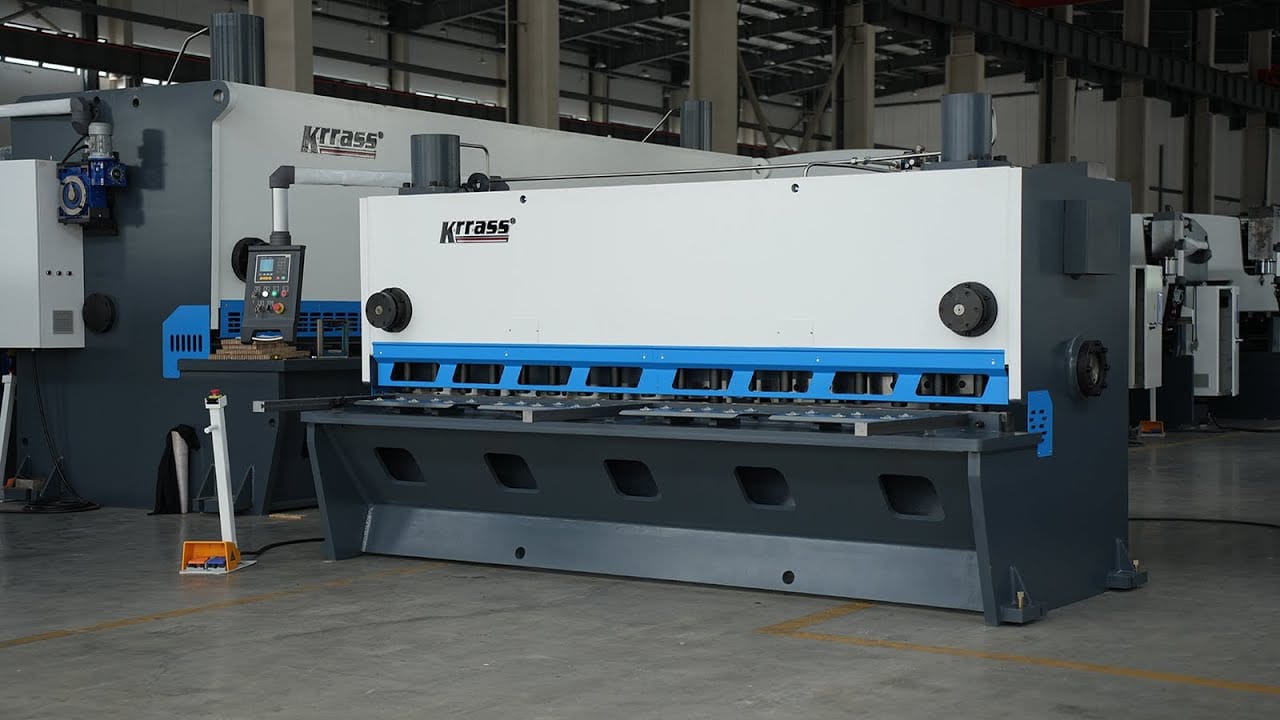
KRRASS Hydraulic Shearing Machine
When I think about reliable hydraulic shears, KRRASS always comes to mind first. I trust this brand because it has a long history. KRRASS started making machines in 1995. Over the years, I have seen them focus on quality and customer needs. They build their machines to last. I like that KRRASS listens to feedback and keeps improving their products.
KRRASS stands out because they offer more than just machines. They give me peace of mind with strong after-sales support. If I have a question or need help, their team responds quickly. I also like that KRRASS sells directly from the factory. This helps me save money and get the latest models. Their research and development team always works on new technology, so I know I am getting a modern machine.
If you want a partner who cares about your workshop’s success, KRRASS is a smart choice.
QC12K and QC11K Series
I have used both the QC12K and QC11K series in my shop. These models make my work easier and faster. They come packed with features that help me get clean, accurate cuts every time. Here is a table that shows what I like most about these machines:
| Feature/Benefit | Description |
|---|---|
| Steel Plate Welding Structure | Gives the machine stability and keeps it reliable for years. |
| Advanced Hydraulic Valve Group | Fewer pipes mean fewer leaks and easier maintenance. |
| Smooth and Fast Return Stroke | Lets me work quickly without waiting for the blade to reset. |
| Manual Blade Gap Adjustment | I can set the blade gap fast and easy, so my cuts stay sharp and clean. |
| Manual Lifting for Rear Stop | Helps me cut extra-long plates without trouble. |
| Rolling Material Support Ball | Stops scratches and makes moving metal smooth. |
| Adjustable Shearing Angle | Reduces bending and lets me cut thick plates with less effort. |
| Manual Oil Pump | Keeps key parts oiled, so the machine lasts longer. |
| Light-Centering Device | Makes it easy to line up cuts and adds a safety layer. |
| Consistent Shearing Angle | Every cut stays precise, even during long jobs. |
These features help me finish jobs faster and keep my workshop running smoothly. I notice less downtime and fewer mistakes when I use these models.
Other Notable Brands
I have tried other brands in my search for the best hydraulic shear. Some brands, like Jiangsu Yawei and JFY, also make good machines. But when I compare them to KRRASS, I see some differences.
KRRASS leads in durability and support. Their machines feel solid and last longer in my shop. I also see that KRRASS invests more in research and development. This means I get new features and better performance. I like that KRRASS offers help both online and offline, no matter where I am.
- KRRASS has a top R&D team that brings new ideas to their machines.
- They sell directly from the factory, which saves me money.
- Their after-sales support covers me worldwide, both online and in person.
When I choose a hydraulic shear, I want a brand that stands by its products. KRRASS gives me that confidence every time.
Tips for Buying Shears
Feature Checklist
When I start buying shears, I always make a checklist. This helps me stay focused and not miss anything important. I look at what my workshop needs most. Here’s a simple checklist I use:
- Cutting capacity (thickness and length)
- Blade quality and adjustability
- Backgauge system (manual or motorized)
- Control system (easy to use or advanced)
- Safety features (guards and emergency stops)
- Frame strength and build quality
- Maintenance needs and support
- Brand reputation and after-sales service
I like to print this list and bring it with me when I talk to suppliers. It keeps me on track. If I see a feature that stands out, I write it down. This way, I can compare different models side by side.
Tip: Don’t rush. Take your time to check every feature. The right checklist can save you from costly mistakes.
Requesting Demos
I always ask for a demo before I buy any shearing machine. Watching the machine in action tells me a lot. I see how smooth the cuts look. I check if the controls feel easy to use. I listen for strange noises or vibrations. If the supplier offers a demo, I bring some of my own materials. This shows me how the machine handles real jobs from my shop.
Here’s what I look for during a demo:
| What I Check | Why It Matters |
|---|---|
| Cut quality | Clean edges mean less finishing work |
| Ease of operation | Simple controls save time |
| Safety features | Protects me and my team |
| Speed and accuracy | Keeps up with my workload |
If I can’t visit in person, I ask for a video demo. Some suppliers, like KRRASS, offer live video calls. I ask questions and watch the operator use the machine. This helps me feel confident about my choice.
Reading Reviews
Before I make a final decision, I always read reviews. Other buyers share their real experiences. I look for reviews on trusted websites and forums. I pay attention to what people say about reliability, support, and performance. If many people mention the same problem, I take it seriously.
I also check for reviews about after-sales service. Good support makes a big difference if something goes wrong. I like to see how the company responds to questions or complaints. If a brand has lots of happy customers, I feel better about my purchase.
Note: Reviews can help you spot hidden issues or find features you didn’t know you needed. Always read both good and bad reviews to get the full picture.
Negotiating and Support
When I buy a hydraulic shear, I never just accept the first offer. I always talk with the supplier. I ask questions and try to get the best deal. Negotiating helps me save money and get extra value. I want you to feel confident when you buy your next machine.
I start by asking about price. I check if the supplier can give me a discount. Sometimes, I mention other brands or models I am considering. This shows the supplier that I know the market. I also ask about payment terms. Some suppliers let me pay in installments. Others offer special financing. I always ask if they include free shipping or installation.
Support matters just as much as price. I want to know who will help me if something goes wrong. I ask about after-sales service. I check if the supplier offers training for my team. I ask if they have a hotline or online support. I want to know how fast they respond to problems.
Here is a table that helps me remember what to ask during negotiations:
| Negotiation Point | Why I Ask |
|---|---|
| Price | I want the best deal |
| Payment Terms | Easier on my budget |
| Warranty | Protection for my investment |
| Free Shipping | Saves me money |
| Installation | No extra hassle |
| Training | My team learns fast |
| After-Sales Support | Quick help when needed |
I always read the contract before I sign. I check the warranty details. I look for hidden fees. If I do not understand something, I ask for an explanation. I want everything clear before I agree.
Tip: Never rush negotiations. Take your time. Ask questions. Good suppliers want you to feel happy and secure.
I also talk about spare parts. I ask if they keep parts in stock. I want to know how long it takes to get a replacement blade or hydraulic part. Fast support keeps my workshop running. I ask if they offer remote diagnostics. Some brands, like KRRASS, help me fix problems online. This saves me time and money.
I always build a good relationship with my supplier. I stay in touch. I give feedback. When I need help, they know me and respond quickly. Strong support makes a big difference. I feel safe knowing I can get help anytime.
If you want the best deal and strong support, do not be afraid to negotiate. Ask questions. Make sure you get what you need. Your workshop will thank you.
Choosing the right shears for your workshop takes careful thought. I always match machine features to my daily shearing needs. I talk with trusted suppliers like KRRASS before I decide. If you want expert advice or a demo, reach out today. Making a smart choice now means better results and fewer problems later.
FAQ
How do I know which hydraulic shear fits my workshop?
I look at the materials I cut, the thickness, and how much I need to produce. I match these needs to the machine’s specs. If I’m unsure, I ask my supplier for advice.
What safety features should I check before buying?
I always check for guards, emergency stop buttons, and clear controls. These features keep me and my team safe. I also make sure the machine has good training support.
How often should I maintain my hydraulic shear?
I inspect my machine weekly. I check blades, oil levels, and moving parts. I follow the manufacturer’s guide for deeper maintenance every few months. Regular care keeps my shear working well.
Can I cut stainless steel with any hydraulic shear?
Not every shear can handle stainless steel. I check the machine’s specs first. Stainless steel needs more force. I ask the supplier if the model fits my needs.
What is the difference between guillotine and swing beam shears?
Guillotine shears use a straight blade for thick materials. Swing beam shears use a swinging blade for smoother cuts. I pick the type based on my job’s needs.
How do I get support if my machine breaks down?
I contact my supplier or manufacturer. Brands like KRRASS offer remote diagnostics and quick help. I keep their contact info handy for fast support.
Is it better to buy new or used shears?
I buy new shears for the latest features and strong support. Used shears save money but may need repairs. I decide based on my budget and workshop needs.
What should I bring when I request a demo?
I bring my own materials to test the machine. I watch for cut quality, ease of use, and safety features. I ask questions during the demo to learn more.
